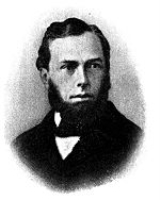
Max Schultze
Encyclopedia
Max Johann Sigismund Schultze (March 25, 1825 - January 16, 1874) was a German
microscopic anatomist noted for his work on cell theory
.
in Breisgau (Baden). He studied medicine at Greifswald and Berlin, and was appointed extraordinary professor at Halle in 1854 and five years later ordinary professor of anatomy and histology
and director of the Anatomical Institute at Bonn. He died at Bonn on the 16th of January 1874. He was the older brother of obstetrician Bernhard Sigmund Schultze
(1827-1919).
He founded, in 1865, and edited the important Archiv für mikroskopische Anatomie, to which he contributed many papers, and he advanced the subject generally, by refining on its technical methods. His works included:
His name is especially known for his work on the cell theory
. Uniting Félix Dujardin
's conception of animal sarcode with Hugo von Mohl
's of vegetable protoplasma, he pointed out their identity, and included them under the common name of protoplasm
, defining the cell as a nucleated mass of protoplasm with or without a cell wall
(Das Protoplasma der Rhizopoden und der Pflanzenzellen; ein Beiträg zur Theorie der Zelle, 1863).
Germany
Germany , officially the Federal Republic of Germany , is a federal parliamentary republic in Europe. The country consists of 16 states while the capital and largest city is Berlin. Germany covers an area of 357,021 km2 and has a largely temperate seasonal climate...
microscopic anatomist noted for his work on cell theory
Cell theory
Cell theory refers to the idea that cells are the basic unit of structure in every living thing. Development of this theory during the mid 17th century was made possible by advances in microscopy. This theory is one of the foundations of biology...
.
Biography
Schultze was born at FreiburgFreiburg
Freiburg im Breisgau is a city in Baden-Württemberg, Germany. In the extreme south-west of the country, it straddles the Dreisam river, at the foot of the Schlossberg. Historically, the city has acted as the hub of the Breisgau region on the western edge of the Black Forest in the Upper Rhine Plain...
in Breisgau (Baden). He studied medicine at Greifswald and Berlin, and was appointed extraordinary professor at Halle in 1854 and five years later ordinary professor of anatomy and histology
Histology
Histology is the study of the microscopic anatomy of cells and tissues of plants and animals. It is performed by examining cells and tissues commonly by sectioning and staining; followed by examination under a light microscope or electron microscope...
and director of the Anatomical Institute at Bonn. He died at Bonn on the 16th of January 1874. He was the older brother of obstetrician Bernhard Sigmund Schultze
Bernhard Sigmund Schultze
Bernhard Sigmund Schultze; sometimes spelled Bernhard Sigismund Schultze was a German obstetrician and gynecologist born in Freiburg im Breisgau...
(1827-1919).
He founded, in 1865, and edited the important Archiv für mikroskopische Anatomie, to which he contributed many papers, and he advanced the subject generally, by refining on its technical methods. His works included:
- Beiträge zur Naturgeschichte der Turbellarien (1851)
- Uber den Organismus der Polythalamien (1854)
- Beiträge zur Kenntnis der Landplanarien (1857)
- Zur Kenntnis der elektrischen Organe der Fische (1858)
- Ein heizbarer Objecttisch und seine Verwendung bei Untersuchungen des Blutes (1865, in which the first known description of the plateletPlateletPlatelets, or thrombocytes , are small,irregularly shaped clear cell fragments , 2–3 µm in diameter, which are derived from fragmentation of precursor megakaryocytes. The average lifespan of a platelet is normally just 5 to 9 days...
) - Zur Anatomie und Physiologie der Retina (1866)
His name is especially known for his work on the cell theory
Cell theory
Cell theory refers to the idea that cells are the basic unit of structure in every living thing. Development of this theory during the mid 17th century was made possible by advances in microscopy. This theory is one of the foundations of biology...
. Uniting Félix Dujardin
Félix Dujardin
-External sources:* @ Encyclopædia Britannica Online...
's conception of animal sarcode with Hugo von Mohl
Hugo von Mohl
Hugo von Mohl was a German botanist from Stuttgart.He was a son of the Württemberg statesman Benjamin Ferdinand von Mohl , the family being connected on both sides with the higher class of state officials of Württemberg...
's of vegetable protoplasma, he pointed out their identity, and included them under the common name of protoplasm
Protoplasm
Protoplasm is the living contents of a cell that is surrounded by a plasma membrane. It is a general term of the Cytoplasm . Protoplasm is composed of a mixture of small molecules such as ions, amino acids, monosaccharides and water, and macromolecules such as nucleic acids, proteins, lipids and...
, defining the cell as a nucleated mass of protoplasm with or without a cell wall
Cell wall
The cell wall is the tough, usually flexible but sometimes fairly rigid layer that surrounds some types of cells. It is located outside the cell membrane and provides these cells with structural support and protection, and also acts as a filtering mechanism. A major function of the cell wall is to...
(Das Protoplasma der Rhizopoden und der Pflanzenzellen; ein Beiträg zur Theorie der Zelle, 1863).

